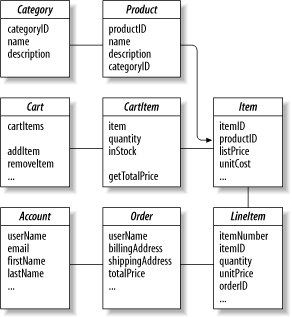|
|
< Day Day Up > |
|
8.3 The Domain ModelIn keeping with the principles in the book, the foundation of the application is the transparent domain model in Figure 8-3. The domain model contains the business relationships of objects that represent the real world. Pet Store is made up of carts and orders that contain items. Figure 8-3. The center of an application is the domain model The application represents a simple pet store. It consists of a shopping cart containing cart items, which feeds an order containing line items. Items consist of products organized into categories. Each object is a transparent business object implemented as a Java bean with some properties and some business methods. Example 8-2 shows a CartItem. I've eliminated the imports and package detail, for brevity. Example 8-2. CartItem.java[1] public class CartItem implements Serializable { /*Private Fields*/ private Item item; private int quantity; private boolean inStock; /*JavaBeans Properties*/ [2] public boolean isInStock() { return inStock; } public void setInStock(boolean inStock) { this.inStock = inStock; } public Item getItem( ) { return item; } public void setItem(Item item) { this.item = item; } public int getQuantity( ) { return quantity; } public void setQuantity(int quantity) { this.quantity = quantity; } [3] public double getTotalPrice() { if (item != null) { return item.getListPrice( ) * quantity; } else { return 0; } } /*Public methods*/ public void incrementQuantity( ) { quantity++; } } Here's what the annotations mean:
I call this model passive. It's invoked entirely by objects outside of its domain and has coupling only to other objects within the domain. Notice that it is not merely a value object, although it does have private properties and public fields It has business methods to calculate the total price and increment the quantity. This design makes this business object easy to understand and reuse, even though the overall design may evolve. As we move into persistence, you'll see other parts of the model as well. |
|
|
< Day Day Up > |
|